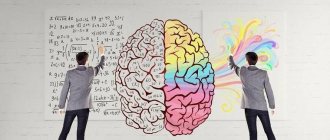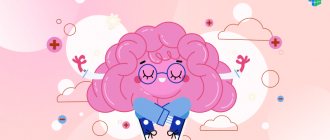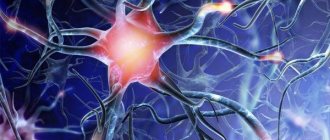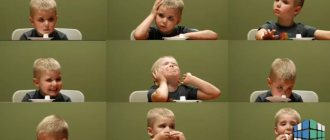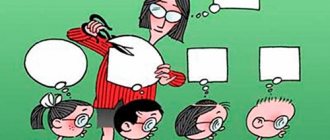Updated July 20, 2021 514 Author: Dmitry Petrov
Hello, dear readers of the KtoNaNovenkogo.ru blog. We can perceive objects: their color, shape, size. Build a logical chain between them. Imagine in your head with your eyes closed. And also think about absolutely abstract things and make plans for the future.
All this is provided by our thinking. It is limitless in its functions and manifestations. To date, all processes have not been fully studied. But we will still tell you something interesting here.
Thinking is...
Thinking is a cognitive process through which the reality around us is reflected, a way of interacting with the outside world. Often thinking is associated with a task and problem that needs to be solved.
It has two important features:
- This is mediation . A person first perceives information through the senses. Through these sensations the idea of objects is formed. You reach some properties through others, and based on facts you can think about broader things.
- The second is generality , which is related to the first feature. All properties of objects are combined with each other. And a person connects them while thinking like a puzzle, and thus the overall picture of the world appears.
As they said earlier, thinking actively works when resolving a situation. The process of gradual development of thinking can be described in 4 stages:
- Awareness of the presence of a problem after analyzing information over a period of time.
- Formation of hypotheses and search for solutions.
- Testing hypotheses.
- Solving a problem situation.
Thought processes
To solve a problem and reveal the essence of a phenomenon/situation, thought processes are activated. Depending on the purpose, one or another type of information processing will be used.
Analysis and synthesis
Synthesis is the combination of details, properties and actions into a holistic picture, depending on the relationships between these parts.
Analysis is the reverse process of synthesis, which consists of decomposing the whole into smaller bricks.
People can do this practically by connecting their thinking. For example, in kindergarten, at work. A clear and simple example would be the same constructor or the construction of a house.
This can also happen exclusively logically in the head, analyzing the general situation into individual important nuances. For example, revealing different sides of a new acquaintance, although before this you had a presumptive image of his personality.
Comparison
Comparison is the establishment of differences and similarities between objects and phenomena.
At the heart of this process is analysis. Because first you need to identify several main features in order to compare them later.
The comparison can be superficial or deep depending on the time spent and ability to analyze the details. And also one-sided and multilateral - did a person need to pay attention to only one aspect, or was their combination important?
Specification
Concretization is clarification, detailing the properties and descriptions of an object or situation. When the ray of attention is completely aimed at one point, and thinking works only in this direction.
Abstraction
Abstraction is the opposite of the above concept. A person is distracted from all the features of an object in order to consider one characteristic in more detail. So that others do not interfere or influence perception. It is through this process that scientists work on their theories and inventions.
Types of thinking in psychology
Back in school we were taught what types of thinking exist. We are not sure that this information has been preserved in full format, so let us remind you.
Visually effective
This type of thought process relies directly on the perception of objects, so the baby’s development begins with it. In another way it can be called concrete or practical . Aimed at solving technical problems.
In this type of thinking, the mental and practical parts interact. The important aspects here :
- observation and special attention to detail;
- use of work schemes;
- the ability to quickly move from thought to action.
Visual-figurative thinking
Here the images and ideas of a person, his imagination, already appear on the stage. The information that a person has perceived from the world around him is embodied in various images in his head.
During such thinking, completely different pictures may appear that have not been seen in reality before. Creative ideas are generated. This type of thought process is well developed in creative individuals and inventors.
Verbal-logical
Consists of concepts and logical connections between them. As a rule, it is more necessary to establish connections between incidents, objects, and people.
Otherwise called abstract . Because this includes the ability to imagine things that cannot be seen or touched in reality. For example, love or happiness.
All types of thinking are interconnected and are often equally developed in humans. Depending on the situation, the most suitable one is activated to solve the problem.
Two levels of individual characteristics of human thinking
Individual characteristics of human thinking in psychology are analyzed at two different levels: the individual and the personality.
When talking about a person as an individual, we consider certain neurodynamic characteristics and processes. We are talking about the following:
- How do the first and second signaling systems relate and, accordingly, what type of thinking, artistic or mental, predominates.
- How nervous processes proceed: the speed of acquiring knowledge, mental performance, and human sensitivity depend on their strength or weakness. The speed of thinking and its flexibility or, on the contrary, difficulty depend on their activity or, on the contrary, inertia.
Personal factors of thinking include:
1. Installation (operational and semantic).
Operating is the readiness to take some steps, while relying on previous experience and assuming the development of events taking into account existing conditions.
Semantic – a higher level setting. It acts as a kind of filter that corrects operating settings. Meaningful attitudes determine the content, pace of development, and performance of the individual as a whole.
2.Motives. They activate and structure thinking. Meaningful motivation imparts valuable personal meaning to thinking.
3.Emotions. They help evaluate information, activate thinking, reduce the time required to find a solution to a problem, and generate new information. perform four functions: evaluative, activating, the function of heuristics (techniques that reduce the time of searching for a solution to a problem), the function of a generator of new information.
4.Personal past experience. It is concentrated in a person’s knowledge and determines the characteristics of his thinking. Only well-structured knowledge turns a person into an intellectual and distinguishes him from an amateur.
5. Socio-psychological factors. Thus, the authoritarianism of teachers and parents gives rise to stereotypical thinking, absence or low level of creativity. On the contrary, parity in relationships creates the preconditions for independence, criticality, originality of thinking, the ability to take into account the position of another person and, as a result, for creative productivity.
Quality thinking
Since thinking is one of the mental processes, it is as individual as character or temperament.
It can be characterized by the following criteria :
- Breadth – the ability to cover a wide range of issues, knowledge in different industries, and the ability to think creatively.
- Depth is the ability to foresee a situation in advance after analysis, the ability to penetrate to the essence.
- Flexibility - quickly change your strategy depending on how circumstances change. Using different types of tactics, as well as the ability to find new solutions.
- Independence is the ability to set the right goal yourself and find an approach to it. This is also where creativity and creative potential comes into play.
- Originality is the ability to produce new ideas that differ from the generally accepted ones.
- Initiative – a constant desire to bring something of your own; solve the problem if you have not yet been made a performer.
Thinking as a cognitive mental process
There are several definitions of the concept of “thinking” in modern psychology. In a general sense, thinking is understood as a mental process that is built on generalization and reflection of reality with verbal participation.
Thinking is one of the main human functions. Thanks to thinking, humanity has a certain set of knowledge about the structure of the world and can transfer this knowledge to subsequent generations.
Thinking includes comparison, comparison, forecasting, analysis, information search. Thinking is the highest form of cognitive activity. Thinking has a motive, a goal, involves actions, exercises control, and has a result.
Note 1
The peculiarity and difference of thinking from other psychological processes is that thinking reflects not only the external characteristics of objects, but also internal connections and relationships. Generalization is another feature of the thinking process. In other words, thinking is symbolic in nature and is expressed through speech.
Finished works on a similar topic
Course work Types of mental processes: thinking 450 ₽ Abstract Types of mental processes: thinking 240 ₽ Test work Types of mental processes: thinking 200 ₽
Receive completed work or specialist advice on your educational project Find out the cost
Critical thinking
Another important characteristic is criticality. It is with it that a person can objectively evaluate the world around him.
Critical thinking is a system of judgment for analyzing everything around, on the basis of which conclusions are drawn. Based on logic and cause-and-effect relationships, one can determine what is truly true.
Some practical examples of use:
- Effective problem solving at home and at work. Achieving the goal faster and more accurately.
- Recognizing real arguments from a set of words when communicating with others.
- Using as evidence the opinions of truly knowledgeable persons (experts). The ability to competently use facts to prove your point of view and lead a discussion.
- Identify key ideas in books and lectures.
- The ability to understand someone else's worldview.
What can a person with well-developed critical thinking do:
- be convincing;
- listen carefully and study information;
- analyze and criticize;
- express yourself competently;
- easily justify your point of view;
- make decisions quickly in new situations;
- interpret effectively;
- reason logically;
- form and voice your own judgments.
Divergent and convergent thinking
These complex names are used, as a rule, to describe work in a team. But this can also concern thoughts in the head of one person. Now we will explain everything in accessible language.
Divergent thinking is the discovery and expression of new ideas without the opportunity to criticize and discuss. This type of thought process allows you not to stop your imagination and produce whole streams of sometimes good solutions to problems, sometimes complete nonsense.
Accordingly, convergent thinking is the assessment and analysis of ideas in a brainstorm. During such rational selection, many decisions are immediately discarded. And others, in a repeated circle, succumb to critical thinking.
In order to find a way out of the situation quickly and effectively, you should not go to extremes. Because you can either generate a huge pile of unrealistic ideas or get stuck in an analytical stupor, afraid to assume anything.
Natural planning model
David Allen's book “Getting Things Done” describes the natural planning model. To perform almost any action, your brain takes five steps:
- defines purpose and principles;
- visualizes the result;
- brainstorms;
- carries out the organization;
- defines the following specific actions.
These five phases of project planning occur naturally no matter what you do during the day. This is how you create something new, be it a dinner at a restaurant, a nice evening, a new product or a new company (read more about the five steps).

